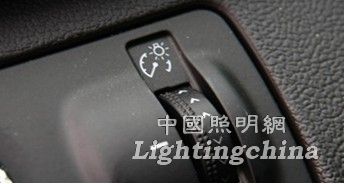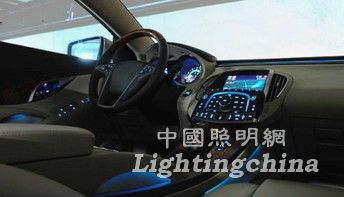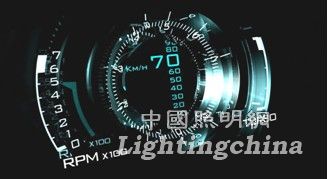1 Introduction
The interior lighting system of the car is chosen by most users to purchase cars in daylight hours with good lighting conditions, so lighting problems inside the car are often neglected. However, when driving in an environment with poor external lighting conditions, it may be difficult to quickly and accurately read various types of driving information fed back by the automobile instrument, and the efficiency of information reading is significantly reduced. If the interior lighting does not respond in time, the lack of lighting will bring tension to the user's mind, which inevitably increases the probability and psychological burden of the user's misoperation.
2 Lighting design should follow the law of vision
The human eye's reflection on light is divided into bright adaptation and dark adaptation. Ming adaptation refers to the human eye turning from dark to bright, this process takes about 60 seconds; on the contrary, dark adaptation takes about 30 minutes, when the user exercises from the normal lighting environment. In environments where lighting is lacking, such as tunnels, bridges, and underground garages, users may experience temporary obstacles in obtaining driving information.
First of all, in the lighting design, it is necessary to cooperate with the driving computer. The driving computer senses the change of the external lighting at any time, and automatically adjusts the lighting of the interior according to the lighting conditions of the external environment, or the user manually adjusts according to the actual demand. As shown in Figure 1: a car adds an adjustment wheel to the steering wheel to adjust the light to better adjust the light according to your needs.

Figure 1 Illumination adjustment wheel integrated on the steering wheel
Secondly, in the lighting design, if the light directly enters the user's eyes, it will produce glare. The glare will cause the user to feel discomfort due to strong visual stimulation, which seriously affects the driving safety of the user. The light required for automotive instrumentation illumination needs to be transmitted to the user's eye in the form of reflection or diffraction to avoid glare, allowing the illumination to be within the visual threshold acceptable to the human eye.
Thirdly, it is necessary to scientifically and rationally manage the color design of the light source. Because the user is affected by factors such as age, gender, personality, occupation, aesthetic psychology, etc., different colors will produce different likes and dislikes. For example, the sports style models choose red and orange in the warm color as the main light source color, the color purity is high, the light penetration is good, the sports style is outstanding, and the reasonable stimulation of the user's psychology is enhanced to generate a stronger driving desire; On the contrary, the business style models choose blue or white in the cool color as the main light source. After the light source is mixed, the color purity is reduced, which caters to the low-key and implicit psychological needs of the business vehicle users.
3 Optimize lighting to assist in the transmission of information and improve information feedback efficiency
As the additional functions of the car continue to enrich, it is followed by more and more information feedback from these on-board devices, users need to control more than simple driving. This means that users need to respond to more information feedback during the driving process. The increased information feedback will distract the driver and increase the risk of driving. The intervention of a large amount of information will inevitably interfere with the driving behavior of the user. The lighting design designer can adjust the illumination value of the light and perform color management according to the visual rule, and effectively filter the feedback information of the instrument. Can also be controlled by the traffic computer and the user behavior related to the current operation information of the carriageway luminance value, luminance value increase core information, secondary information is decreased luminance value, reducing the user's visual capacity per unit time, data from different types of feedback The color classification control adopts constant flashing illumination on the sudden warning information to stimulate the user and improve the user's attention to guide the user's operation. As shown in Figure 2, meter illumination filters information through different levels of LED illumination intensity.
4 increase the pleasure and friendliness of the lighting design to provide users with comfortable lighting
In addition to traditional instrument lighting, LEDs are used in a large number of automotive lighting applications. LED is a kind of lighting material that can be easily controlled. By adjusting the voltage level, LED lighting of different colors can be obtained. Most of them are integrated in various buttons and knobs of the center console panel, and appear in the form of contour lights. LED lighting instructions are simple, clear and friendly. In the interior lighting of cars, most of the interiors of the car are designed with cold colors in the design of instrument lighting. Unlike traditional incandescent lighting, the design of comfortable lighting will use LED lighting. LED lighting has strong penetrating power. , low energy consumption and diverse colors. Emotion setting mode can be used in different interior spaces to control the light color and brightness of "personal space", for example, the driver's foot space or the backlight of the console. The comfort lighting visual effect meets the aesthetic needs of modern people and complements the regular interior lighting to provide a soothing space for the passengers inside.
Add door handle lighting, engine start keyhole lighting, glove box lighting and cup holder lighting inside the car, which can provide users with operating instructions in case of night driving, avoiding the possibility of misoperation and providing users with barrier-free operation. The environment provides users with a pleasant driving environment. In some high-end brand models, the configuration of the ambient light is added inside the cabin. The ambient light was originally used in the design of home and commercial space, with the aim of enhancing the indoor space environment and lighting visual effects. Introducing the ambient light from the field of environmental design into the interior lighting design is no longer just to meet the functional requirements of the user's lighting, but to provide users with more visual aesthetics and increase the comfort of the user's driving environment, as shown in Figure 3. Shown, the actual effect map of the ambient light used in the interior space of a certain model in China.

Figure 3 Ambient light creates a comfortable interior atmosphere for the user
5 Provide users with a design that demonstrates their own value
In automobile consumption, the market breaks down many levels of consumption and consumption concepts. Consumers around the world, especially those in Asia, want to drive their cars to effectively convey their image, wealth and social status. In addition to the car's brand, price, exterior styling, configuration can be divided into consumption levels, then we can strengthen the brand identity in the light.
In the design of luxury models, the brand logo is often added to the pedals that are accessed by the door. When the parking user opens the door, the pedal lights will be activated to provide illumination and guidance for the user to enter and exit the car, and at the same time, indicate the brand image to the surrounding environment. To increase the level of consumption.
6 Summary
User-centered design of automotive interior lighting is a scientific lighting system that achieves a comfortable lighting system that meets the functional and psychological needs of users, allowing users to experience humanized design care and also for automotive manufacturing. Enterprises will increase their odds in the more competitive auto market competition in the future.
references:
[1] Make Dale, Advanced Automotive Lighting System, Automotive Repair and Maintenance, April 2002 [2] Xu Xun, On the Commercial Value of Automotive Colors, College of Art and Design, Zhejiang University of Science and Technology, 310023
[3] Liu Sha, Design Psychology, Shanghai People's Fine Arts Publishing House, January 2009 [4] (US) Michael R. Solomon, Consumer Behavior, Beijing Electronics Industry Press, November 2006 [5] Donald A. Norman Beijing: CITIC Publishing House, March 2003
UCD: Short for User-Centered Design, Chinese means user-centered design. As a very attractive and efficient way to experience the user experience, the design idea is very simple, that is, in every step of developing the product, the user should be considered.

Figure 2 Filtering information through different levels of light sources
Solar Desk,Wall Light,Solar Wall Light,Solar Desk Light
jiangmen jieken lighting appliance co.,ltd , https://www.jekenlighting.com